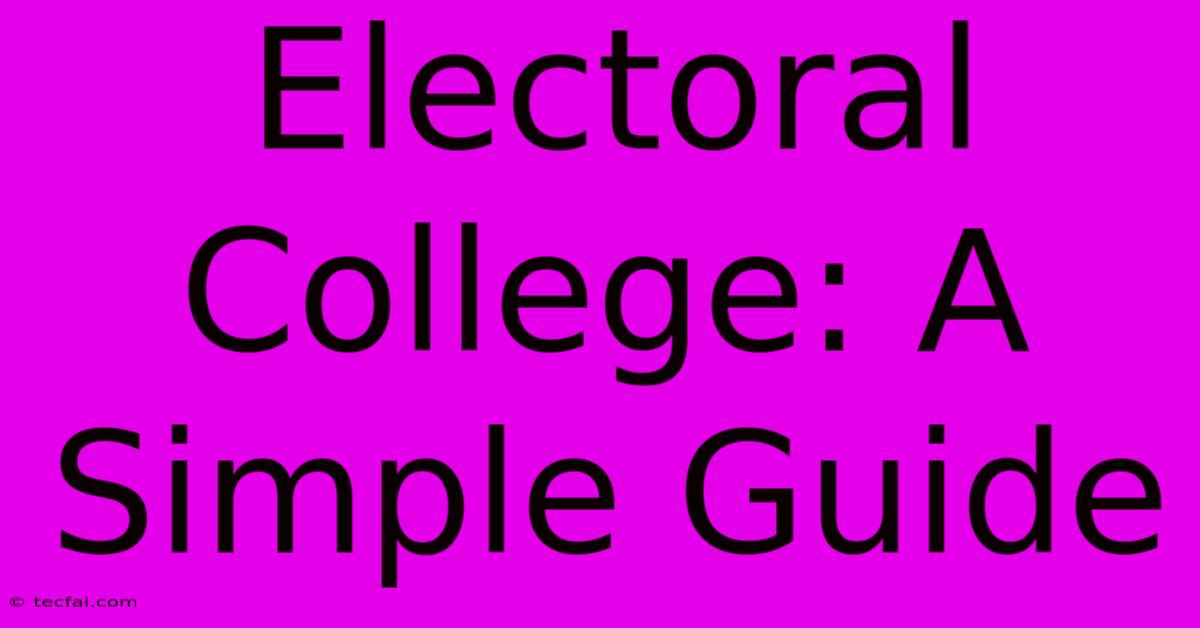Electoral College: A Simple Guide

Discover more detailed and exciting information on our website. Click the link below to start your adventure: Visit Best Website tecfai.com. Don't miss out!
Table of Contents
Electoral College: A Simple Guide
The Electoral College is a unique system used in the United States to elect the President and Vice President. While it's a familiar term, many people don't fully understand how it works or why it exists. This guide will break down the Electoral College, offering a clear understanding of its mechanics and addressing some common questions.
What is the Electoral College?
The Electoral College is a group of electors established by the Constitution, representing each state and the District of Columbia. Instead of a direct popular vote, the President and Vice President are elected based on the number of electors each candidate wins.
How Does It Work?
1. Allocation of Electors:
Each state receives a number of electors equal to its total number of representatives and senators in Congress. The District of Columbia has three electors. This means states with larger populations have more electors than smaller states.
2. The Popular Vote:
During the presidential election, voters cast ballots for their preferred candidate. These votes are tallied at the state level.
3. The Electoral Vote:
In most states, the candidate who wins the popular vote in that state wins all of its electoral votes (a system called "winner-take-all"). There are a few exceptions, including Maine and Nebraska, which use a proportional allocation of electors.
4. Reaching the Majority:
A candidate needs to win at least 270 out of 538 electoral votes to become President. If no candidate reaches this majority, the election is decided by the House of Representatives.
Why Does the Electoral College Exist?
The Electoral College was established by the Founding Fathers for several reasons:
- To protect the interests of smaller states: Without the Electoral College, the candidate winning the most populous states would likely always win.
- To ensure a national election: The Founders wanted to ensure a candidate had to appeal to voters across the entire country, not just concentrated urban areas.
- To avoid a direct popular vote: The Founders were concerned about the potential for mob rule and believed the Electoral College would provide a more reasoned approach to selecting the President.
Common Questions About the Electoral College
1. Can a candidate win the popular vote but lose the Electoral College?
Yes, this has happened five times in US history, most recently in 2016.
2. Is the Electoral College fair?
This is a highly debated topic. Supporters argue that it ensures representation for all states, while critics contend that it can result in a candidate winning the presidency without winning the most votes nationwide.
3. Can the Electoral College be changed?
Yes, the Constitution can be amended to abolish the Electoral College, but this would require a two-thirds majority vote in both the House of Representatives and the Senate, as well as ratification by three-quarters of the states.
Conclusion
The Electoral College is a complex and often controversial system. Understanding its mechanics and its historical context is essential for appreciating the nuances of American presidential elections. While it continues to be debated, the Electoral College remains a significant part of the American political landscape.

Thank you for visiting our website wich cover about Electoral College: A Simple Guide . We hope the information provided has been useful to you. Feel free to contact us if you have any questions or need further assistance. See you next time and dont miss to bookmark.
Featured Posts
-
Packers Pff Grades Week 9 Loss To Lions
Nov 05, 2024
-
Melbourne Cup 2024 Top Horses To Watch
Nov 05, 2024
-
Joe Rogan Endorses Trump On Election Eve
Nov 05, 2024
-
Toronto Vs Denver Nba Preview
Nov 05, 2024
-
2024 Acc Field Hockey All Conference Selections
Nov 05, 2024
